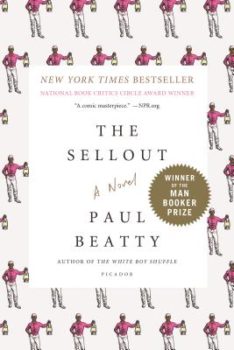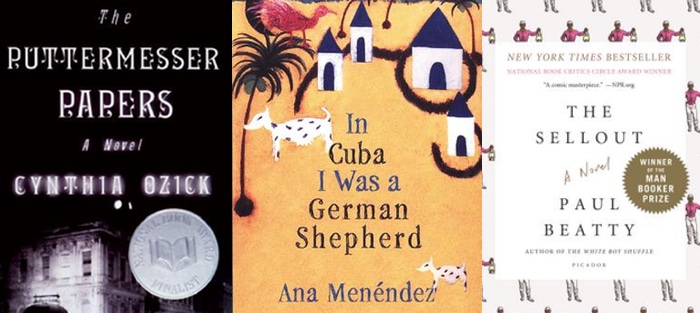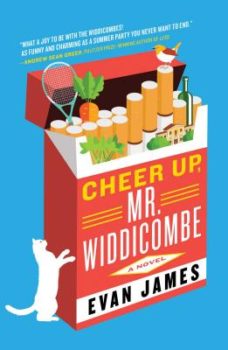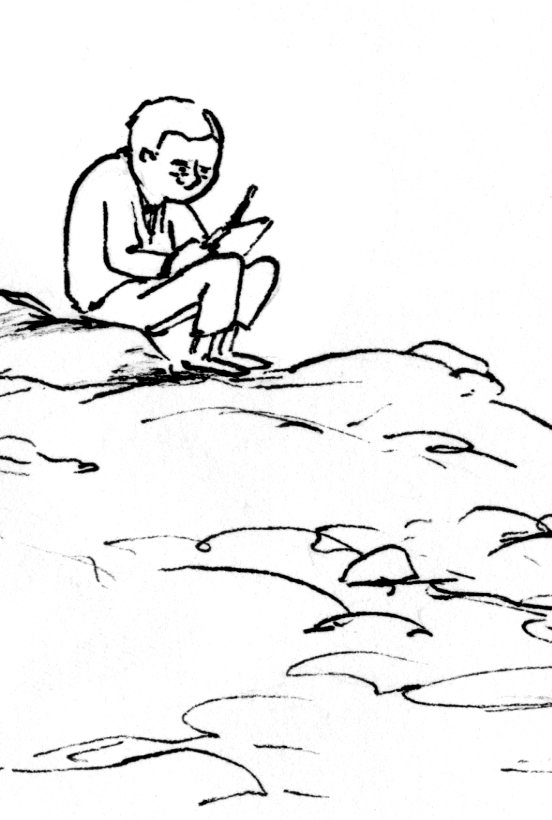Here’s a joke from the 4th or 5th century, CE: Shopping for windows, a Kymean asks if there are any that look south.[1]
Here’s a joke I heard two years ago, at my MFA program: What’s the difference between a poet and a large pizza? A large pizza can feed a family.
These jokes are conditional jokes.[2] That is, they’re jokes which work when listeners have the information necessary to get the point. They have something else in common: in both instances, the conditional information is supplied by the joke itself. I have no doubt that readers understood the jokes even if they came to this essay ignorant of the way the ancient world stereotyped Kymeans and unaware of the presumed impecuniousness of poets.[3] Conditional jokes can educate, and that means that they can be used as exposition.
Done badly, exposition can interrupt a story with a lecture, change the narrative distance, or force characters into artificial behavior—reminiscing where reminiscence isn’t called for or telling people things they already know. Jokes avoid those pitfalls. They engage readers because they’re lively, short, and have unexpected endings. They don’t distort character behavior or change narrative distance, because all kinds of people—all kinds of characters—engage with jokes as tellers and listeners.
What’s more, jokes can deliver information in a way that gets through to readers. The narrator of Paul Beatty’s The Sellout says, of a comedian at an open mic night, “This traffic-court jester did more than tell jokes; he plucked out your subconscious and beat you silly with it, not until you were unrecognizable, but until you were recognizable . . . ”
Look, for instance, at the way Cynthia Ozick uses a joke in her story “Save My Child!” The story, published in 1996 and set somewhat earlier, is about an American Jewish woman, Ruth Puttermesser, who gets a call from a relative in the Soviet Union, someone she’s never met. The relative begs, “Save my child!” Puttermesser understands (or thinks she does) what the caller means.
For the story to work, readers must know at least some of what Puttermesser does about the dangers facing Jews in the Soviet Union. So, the story references Puttermesser’s family history (her father fled “the brutish Russia of the czars”), her knowledge of things like Stalin’s murder of Jewish poets, and the way “the old darknesses were creeping out in the loosened Soviet Union.” Then Ozick adds a joke:
Puttermesser picks up a joke that is at this very moment circulating through Moscow: Because there is a rumor of a delivery of meat, a long queue forms outside a butcher shop. After a four-hour wait, the manager emerges to address the crowd: “The meat hasn’t arrived yet, but there won’t be enough for everyone, so all the Jews must leave.” Another four hours pass, and out comes the manager: “No delivery yet, but there won’t be enough, so all the chronic grumblers against the regime must leave.” Another four hours, and finally the manager announces: “Sorry, comrades, but there will be no meat delivery after all. Everyone go home!” And a great man rises up: “Wouldn’t you know it? The Jews are always getting favored!” [4]
How that poisonous joke with its bitter truths reverberated.
As we’ve seen, Ozick helps readers understand the joke—supply the conditions—by providing information before the joke is introduced, but the joke itself instructs. It augments the facts about the plight of Jews in Russia with a short story which elicits an emotional reaction—laughter—from the reader and conveys the can’t-win-for-losing paradox of anti-Semitism better than anything I’ve ever seen. It’s exposition, but it doesn’t interrupt the narrative because Ozick’s told us that jokes like this are part of Puttermesser’s world—something she naturally “picks up.”
Ana Menéndez’s “In Cuba I Was a German Shepard,” published in 1999, is set in Miami, where the main character, Máximo, settled after fleeing Cuba years earlier. The story’s about aging, grief, and longing. In order to understand Maximo and appreciate the story, readers need to have some information about modern Cuban history. Menéndez provides the information through Máximo’s jokes.
On the first page, before any other backstory’s introduced, Maximo tells his friends this one: Bill Clinton dies in office. His body’s frozen, but he’s awakened in 2015. He’s curious, so he asks a Jewish man about the Middle East and an Irishman about Ireland. Both answer that everything’s fine. No problems. When he talks to a Cuban, he’s again told that everything’s fine, but the Cuban adds, “Let me tell you, my friend, I can feel it in my bones. Any day now, Castro’s gonna fall.”
 A little later, Máximo tells a joke about “a bunch of rafters” on a Cuban beach, ready to sail for Miami. They see Fidel, also with a raft and headed for Miami. The other rafters tell him, “If you’re leaving, then there’s no reason for us to go. Here, take my raft, too, and get the fuck out of here.”
A little later, Máximo tells a joke about “a bunch of rafters” on a Cuban beach, ready to sail for Miami. They see Fidel, also with a raft and headed for Miami. The other rafters tell him, “If you’re leaving, then there’s no reason for us to go. Here, take my raft, too, and get the fuck out of here.”
The jokes say that Castro robbed people of their homes and their country. The problem’s long-standing and intractable. Máximo and others like him are exiles. They’ve had hope, but they’re defeated. In Máximo’s community, those opinions aren’t controversial. They’re bedrock facts. Because the information comes in through jokes, through a character who chooses to communicate with jokes, it doesn’t interrupt the story. Instead, readers understand Máximo’s situation and see his attempt to tell his story without revealing his pain.
The opportunity for exposition through joke doesn’t end when a joke is told, because jokes told by a character invite reactions from other characters. In Menéndez’s story, after the first joke, one listener reinforces the information about the intractability of the Castro problem by complaining that the joke is old: “I heard it when Reagan was president.”
Máximo tells one more joke, one about a little dog (male), just off the boat from Cuba, trying to impress a fancy (female) American poodle. The poodle rejects him, saying that he’s a short, insignificant mutt. He answers, “‘Here in America, I may be a short, insignificant mutt, but in Cuba I was a German shepherd.'” Máximo’s friends love the joke, but after he tells it, Máximo turns “so the men would not see his tears.” The joke and its reception vividly present Máximo’s loss of homeland, status, and a place in the world.
Exposition isn’t the only work that conditional jokes do in those stories. It’s inevitable that a conditional joke will work differently for readers who need the condition explained, and those who don’t. If a work of fiction is concerned with inclusion and exclusion in a given group, conditional jokes can amplify that theme. It’s especially true when the jokes are the kind of inside jokes which many groups, perhaps every group—ethnic, religious, geographical, professional—tell about themselves. Often, those jokes convey the group’s sense of itself, its struggles, and its place in the world. They can be, or seem to be, self-deprecating, and they play with stereotype. When this kind of joke is about, for instance, lawyers or poets or residents of a particular state, it will be easy enough for readers who aren’t lawyers or poets or residents of that state to participate in the joke—to understand it, laugh at it, retell it.
It’s not as easy if the jokes come from a racial, ethnic, or religious group. With those jokes, the true conditions tend to be affective—emotional—rather than factual. Readers who are outside the characters’ group may well be able to supply the factual conditions, so that they understand the jokes and see the humor, but they can’t fully participate, because the jokes don’t only depend on the facts. They depend on the way the listener—the characters and the readers—feel about them. In those instances, for an outside reader, participation in the joke can feel like trespass. That reader may also be aware that the joke, as funny or insightful as it might be on the page, would be ugly if told by outsiders—by that reader. All of that will give the outside reader an experience of exclusion, that is, an experience of the story’s theme.
 That’s at work in the examples already discussed. Puttermesser finds the meat-train-from-Moscow joke poisonous, but Ozick makes it clear that she’s not shocked by the joke or surprised by the fact that people are joking about anti-Semitism, although in my experience—it’s an old joke, and one I’ve told—many people, unfamiliar with Jewish humor of a certain era, do find the joke shocking. They understand it intellectually, but don’t find it funny, and even if they do, they don’t always laugh. That would feel perilously close to laughing at the misfortune of others.
That’s at work in the examples already discussed. Puttermesser finds the meat-train-from-Moscow joke poisonous, but Ozick makes it clear that she’s not shocked by the joke or surprised by the fact that people are joking about anti-Semitism, although in my experience—it’s an old joke, and one I’ve told—many people, unfamiliar with Jewish humor of a certain era, do find the joke shocking. They understand it intellectually, but don’t find it funny, and even if they do, they don’t always laugh. That would feel perilously close to laughing at the misfortune of others.
When I read “Save My Child!” I felt close to Puttermesser and the story because we shared that joke. Outsiders won’t feel that closeness, but their discomfort with the joke will strengthen their engagement with the story in a different way. The shock will alert them to the fact that they (like Puttermesser) have something to learn, and the small bit of work it takes to understand the joke and Puttermesser’s reaction to it is an investment in the story which will carry the reader onward.
The affective condition is explicit in “In Cuba I Was A German Shepard.” After the “rafters” joke, Menéndez tells us that one character is careful not to laugh too hard. He’s Dominican, not Cuban, and he knows that he doesn’t understand “all the layers of hurt in the Cubans’ jokes.” The Dominican, of course, is a surrogate for readers, most of whom won’t be Cuban exiles like Máximo and his friends. They’ll feel sympathy, but as the Dominican points out, sympathy isn’t the same as experience. The contrast between the readers’ stance and the Cubans’ will help readers feel the depth of the Cubans’ pain.
In both those stories, the writers use jokes to bring readers inside while at the same time reminding them that they’re outside. The Sellout does this, too, using conditional jokes to great effect.
The Sellout is about the narrator’s efforts to reanimate an historically black Los Angeles neighborhood called Dickens, which is so important to the community that one character says, “When Dickens disappeared, I disappeared.” The novel is about race, and about belonging and not belonging in Dickens, in the rest of Los Angeles, in the world. The jokes reinforce those themes because they’re inside jokes that work in different ways for different readers, who do, or don’t, supply the affective conditions. Do, or don’t, belong.
I’ll give an example, but because I’m an outsider to the joke, I’m going to sanitize it, even though that hurts the humor. Here it is: the narrator remembers the old joke about a genie granting wishes to three men, in this version, a “redneck,” (I’ve added the quotation marks) a Mexican American, (the narrator just says “Mexican”) and a black man (not the term the narrator uses). The black man’s wish is that his people return to, and prosper in, Africa. The Mexican American makes a parallel wish. The “redneck,” realizing that the people he hates are gone, asks for a Coke.
The joke is about the depth and tenacity of racism, and a marginalized group’s weary knowledge of that fact. Presumably, most readers know those factual conditions. I did, and for that reason, and because I already knew other versions of the joke, when I saw the joke I felt included in the narrator’s world. However, the joke also excluded me, in part because in its original form, it’s full of words I won’t use, and in part because the emotional content is so inside that I was reminded that I’m outside.
 That feeling was exacerbated when the narrator purported to understand the joke for the first time when he drank a delicious Coke. Beatty never goes for the expected, and I found the narrator’s rejection of the obvious meaning of the joke a little shocking, just as the meat-train-from-Moscow joke shocked others. At the same time, I could see that other readers, of different races or nationalities or even with different attitudes, would have different interactions with the joke.
That feeling was exacerbated when the narrator purported to understand the joke for the first time when he drank a delicious Coke. Beatty never goes for the expected, and I found the narrator’s rejection of the obvious meaning of the joke a little shocking, just as the meat-train-from-Moscow joke shocked others. At the same time, I could see that other readers, of different races or nationalities or even with different attitudes, would have different interactions with the joke.
In the New York Times, poet Kevin Young said that The Sellout “breaks open the private jokes and secrets of blackness.”[5] For readers not already not already privy to those secrets, the book makes a private world available for observation, but just as sympathy isn’t experience, observation isn’t belonging. Beatty tells us so. At one point in the novel, white customers are thrown out of a club that hosts an open mic night for black comics. “This shit ain’t for you,” the comic on stage shouts. “This is our thing.” The customers leave. Readers will keep reading, but some of us have been reminded that we’re outside, looking in—again, an experience of the novel’s themes.
I’ll give one more example of the use of a joke, actually joke-telling, in The Sellout. It’s a joke I can decently quote without changes. The narrator complains that the comics at the open mic night “misuse the word ‘plethora,’ . . . As in: Q. How many white boys does it take to screw in a light bulb? A: A plethora! Because they stole it from a black man! Lewis Latimer, a black man who invented the light bulb and a plethora of other smart-ass shit.”
I couldn’t supply either the factual or affective conditions for this failed joke. The joke-teller and his audience know, but I didn’t, that Latimer’s light bulb invention was at least as important as Edison’s, and yes, he was the inventor of a whole lot of other useful things. Even after I learned that, though, couldn’t supply the affective condition. I knew the cause of the joke-teller’s rage, but I didn’t feel it as he did. Even a light bulb joke is different if you are part of, or outside of, Dickens.
Jokes are a part of everyday conversation. Even people who don’t tell them, hear them, and even people who don’t like them, know them. People use them to tell their stories, to shock, to inform, to share—or hide—their fears, and to explain—or enforce—differences. Jokes can amuse. They can educate. They belong in our fictions.
[1] This joke is found in the Philogelos, one of the oldest existing collections of jokes.
[2] The term was coined by philosophy professor Ted Cohen, in Jokes: Philosophical Thoughts on Joking Matters. University of Chicago Press, 1999.
[3] It helps that we tell so many similar jokes. A Kymean joke is an Aggie joke, and a poet joke is a drummer joke. One study of jokes includes a page-length table titled Stupidity Jokes by Country. Christie Davies. Jokes and Targets. Indiana University Press, 2011.
[4] Sadly, this is not the best version of the joke. Even this joke proponent admits that that’s one of the risks of using jokes: joke loving readers will always know a better version.
[5] Of course, this is true of all fictions which include inside jokes. “Books invite all,” it says over the door to the Los Angeles Public Library’s Central branch. The inscription, by Hartley Burr Alexander, ends “they constrain none.” The point of this essay is that they sometimes do constrain, but productively.






